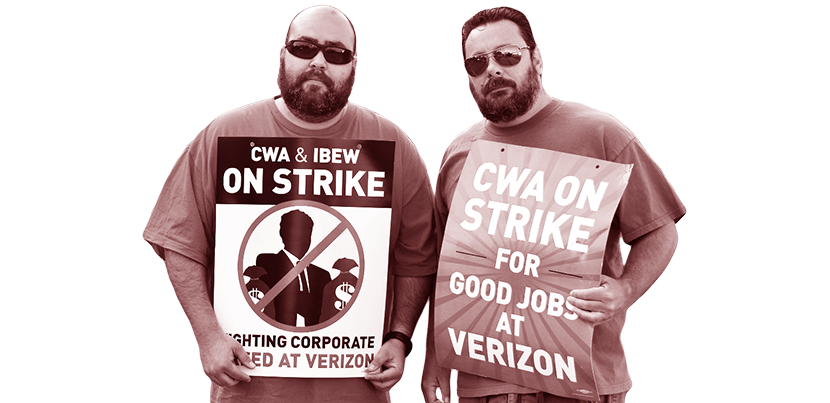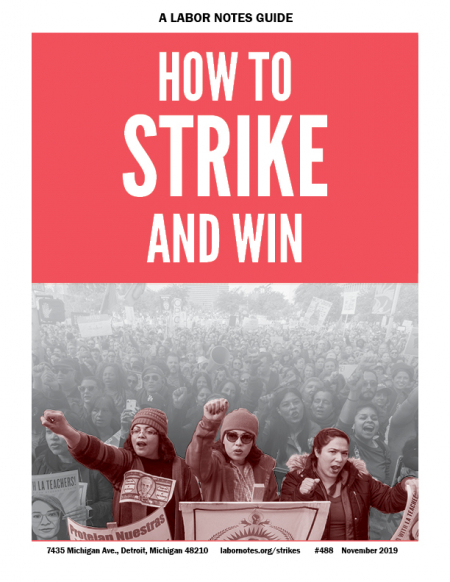Turn Up the Heat

Every action is a test of your union strength and a chance to improve. Photo: Thomas Altfather Good.
Starting with milder actions and building up to more fiery ones will maximize involvement in your contract campaign.
How to Strike and Win
A Labor Notes Guide
labornotes.org/strikes
The Big Picture
Know Your ABC's
Building Blocks
- Turn Up the Heat
- Organize the Organized
- Democracy: Who Owns the Strike?
- Community: Who Else Owns It?
- How to End a Strike
At a Glance
Since members in motion give unions their power, the basic task in a contract campaign is to get members moving.
But people won't go from zero to strike on a dime. You have to build an onramp. Start by getting from zero to one. What are your co-workers ready to do?
Taking even a very mild action together will help. Members will gain an ounce of confidence in their own power. They’ll see that they can rely on their co-workers to act together. Soon they’ll be ready to try something a little bolder.
Early in their 2011-12 contract campaign, Chicago teachers and paraprofessionals started wearing red every Friday as a signal that they were united. The tactic was simple and low-risk. Anyone could do it, even someone who had no extra time.
At first many people would wear a red scarf or a red-patterned blouse. But as their excitement and confidence grew, more and more ordered red union Tshirts. The visibility helped alleviate fears. Co-workers could see for themselves the growing level of union support. Administrators and students saw it, too.
Participating in this action helped get teachers ready to take the next step. It also made visible which schools were not solid red on Fridays—showing the union where new leaders should be recruited or existing leaders needed help.
IT'S A SERIES OF TESTS
THE ACTION THERMOMETER
Here are some actions workers have used in contract campaigns, starting with lowintensity actions at the bottom of the thermometer and gradually heating up.
One campaign wouldn’t include this many tactics. Choose actions that make sense for your group, even if they're not on this list!

- Strike!
- Clean out your lockers together
- Haul burn barrels around conspicuously
- Throw a picket sign-making party
- Set up a strike countdown clock
- 25. Work to rule
- 24. Informational picket
- Wear “ready to strike” buttons
- Display signs in car windows
- Strike vote!
- Refuse overtime
- Distribute window and lawn signs
- Circulate a strike petition or pledge
- Confront the employer at a public event
- Set a strike deadline
- Hold a rally, march, or candlelight vigil
- Crowd into a bargaining session
- Leaflet co-workers on the job
- Rally outside the job before or after work
- March on a supervisor or the CEO
- Hold a public event with allies
- Leaflet customers or the public
- Post selfies with a theme, like “I want a strong
contract because…” - Set up a group on social media, or for texting
- Hold meetings in break rooms to discuss the campaign
- Wear union colors to work once a week
- Circulate a petition on a popular issue
- Distribute union lanyards, shoelaces, or other gear to wear at work
- Hold meetings to develop demands
- Do a survey on bargaining priorities
Every action is a test of your union strength and a chance to improve. Shoot for unanimous participation, but don’t panic if you find holes. Build on what you’ve got. So long as you keep improving participation, you’re on the right track.
If participation starts falling off dramatically, however, it’s time to put on the brakes and regroup. Get your core group together to talk over the obstacles and how to confront them. Don’t just charge ahead with plummeting numbers. No matter how militant the action is, if participation is anemic, it sends a message of weakness to the boss—and to your co-workers, who will start to back away.
A great low-intensity activity to start your campaign is a survey about what people want to win in the contract. (See here.) Bus drivers in Alexandria, Virginia, who unionized in 2018 began their first-contract campaign with a survey.
The union set a goal to talk to everyone, even people who had voted no. The committee kept a running list of who still had to fill out a survey, and drove up participation past 75 percent.
Later in their campaign they packed a city council hearing; promoted their story to local media; set up a workerto-worker texting network; voted to authorize a strike; handed out 10,000 flyers to rush-hour commuters; and countered their employer’s so-called final offer with a final offer of their own. At the last minute, to stave off a strike, management took the deal.
Negotiating sessions create natural opportunities for action, if you’re opening up the bargaining to members (see here).

SUPPORT LABOR NOTES
BECOME A MONTHLY DONOR
Give $10 a month or more and get our "Fight the Boss, Build the Union" T-shirt.
Professors and adjuncts at the University of Oregon insisted that their 2015 negotiations be conducted in public. Each time the two sides met, the union’s Contract Action Team (CAT; see here) packed the room with members wanting to observe. So many faculty members turned out—130 on one occasion—that the meeting had to be moved to a larger room.
An economics professor blogged live accounts from his laptop. “We couldn’t make comments, but we could roll our eyes,” said member Nancy Bray.
PRACTICE, PRACTICE, PRACTICE
Leading up to your strike, organize actions that confirm and reconfirm each individual’s commitment, to make sure your numbers are solid.
When faculty at the City College of San Francisco were campaigning for a contract in 2015, the CAT set out to make one-to-one contacts. They asked each person, “Will you vote to raise dues temporarily to establish a strike fund?” Of 1,500 members, 650 signed commitment cards promising to vote yes. Fewer than 10 percent refused.
The vote backed up those assessments. More than 600 faculty voted, with 93 percent in favor of raising dues. It was the largest turnout in the union’s history. The next step was a petition committing to strike if necessary, gathered through more one-on-ones. Then a vote to authorize a strike, where the union topped its record again, with more than 800 members voting, 92 percent yes.
By the time they actually walked out, members had demonstrated their commitment to one another over and over. The employer too had seen plenty of evidence that they were serious, and had had chances to back out. A strike shouldn’t come as a surprise to anyone.
FLAUNT YOUR DEADLINE
Many unions display their strikereadiness with “practice picketing.” Or a one-day walkout can be a “demonstration strike” before an open-ended one.
UFCW Local 21 used a clever visual aid to spotlight the final days of bargaining for 21,000 Seattle grocery workers in 2013. when four grocery chains were pushing to eliminate health insurance for part-timers.
When the union gave the 72-hour strike notice, it set up a huge notepad displaying the numerals “7” and “2” at a park in downtown Seattle. Each hour a member would flip the page, ticking down the hours till the deadline.
“The cameras were on it all the time,” said Safeway meatwrapper Mary Ann Schroeder. “It was on all the local news. So it wasn’t just happening to us, it was happening to everybody... The whole city knew.”
The countdown stopped at 02, when the chains agreed to a no-concession contract, keeping everyone’s benefits intact.
ESCALATE DURING THE STRIKE
Even once you’re on strike, you never want management to feel you have no cards left to play. Strikers should keep dreaming up ways to ratchet up the pressure. The union should encourage these ideas and put resources behind them.
Oil refinery workers were doing a rolling national strike over safety in 2015 when an explosion at a not-yet-struck refinery in Torrance, California, injured several members and blanketed nearby homes with potentially toxic dust. Steelworkers Local 675 organized a caravan to ExxonMobil’s headquarters, where members in hazmat suits emptied a dump truck of horse manure at the company’s front door and held a sit-in.
Later strikers sat in at a city hall to demand a crack-down on the illegal housing of scabs. They also managed to get inside a meeting of the Western States Petroleum Association and drop a banner, and even launched a fleet of picketers into Los Angeles Harbor by kayak, so maritime unions would know to honor their picket line at a dock. After Homeland Security and the Coast Guard ordered the kayakers to stay 1,000 feet away, the union hired the Illuminator group from Occupy Wall Street to project picket lines onto the facility in lights.
ROVING PICKETS
In 2016, Verizon strikers followed managers and scabs around and picketed the poles, manholes, and buildings where they were working. They took photos and videos of safety violations that were putting the public at risk, and circulated the evidence on Facebook.
To avoid the mobile picketers, Verizon started dispatching scabs in unmarked vehicles from hotels instead of using its regular garages and vans. So CWA and IBEW locals organized “scab wakeup calls” outside the hotels. These rowdy pickets got several hotels to kick out Verizon’s operation—though they also got the locals hit with restraining orders, on the grounds that the tactic was a secondary boycott. (See here.)
Undeterred, CWA and IBEW locals found other ways to keep the heat on Verizon. When the CEO and CFO showed their faces at conferences, hundreds of strikers were there to protest.
The unions sent a delegation to Verizon’s shareholder meeting in Albuquerque, where 15 strikers and supporters were arrested in an act of civil disobedience outside. And after outsourced Verizon call center workers in the Philippines reached out to CWA through Facebook, a delegation of U.S. strikers traveled there.
From the Filipino workers they got some intel about how effective their strike was. The company was so behind on fiber-optic installations that new customers were being told they’d have to wait months for service. And the call center employees were fielding a lot of calls to disconnect service because of the scabs’ lack of professionalism.





